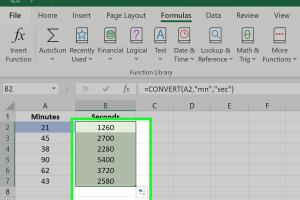Effortless Measurement Conversion in Microsoft Excel: A Comprehensive Guide

-
Quick Links:
- Introduction
- Understanding Measurements
- Excel Basics for Measurement Conversion
- Manual Conversion Methods in Excel
- Using Excel Functions for Measurement Conversion
- Creating Conversion Tables in Excel
- Case Studies: Real-World Applications
- Expert Insights
- Common Mistakes to Avoid
- FAQs
Introduction
Excel is a powerful tool that can simplify various tasks, including measurement conversions. Whether you're working on a project that requires converting inches to centimeters or gallons to liters, Excel can make the task quick and easy. This guide will provide you with everything you need to know about converting measurements in Excel, from basic understanding to advanced techniques.
Understanding Measurements
Measurement conversion is essential in numerous fields, including science, engineering, and everyday tasks. Understanding the different types of measurements—such as length, weight, volume, and area—is crucial before diving into conversion methods.
- Length: Inches, Feet, Meters, Centimeters
- Weight: Pounds, Kilograms, Ounces
- Volume: Gallons, Liters, Milliliters
- Area: Square Feet, Square Meters, Acres
Excel Basics for Measurement Conversion
Before we get into specific conversion methods, it’s important to familiarize yourself with some basic Excel functions and features:
- Cells: The basic unit of storage in Excel.
- Formulas: Used to perform calculations.
- Functions: Predefined formulas that simplify complex calculations.
- Data Types: Different formats for storing data (e.g., numbers, text).
Manual Conversion Methods in Excel
For straightforward conversions, you can perform calculations directly in the spreadsheet. Here’s a simple example:
Example: Converting Inches to Centimeters
The formula for converting inches to centimeters is:
Centimeters = Inches × 2.54
To apply this in Excel:
- Input the value in inches in cell A1.
- In cell B1, use the formula:
=A1 * 2.54. - The result in cell B1 will be the equivalent value in centimeters.
Using Excel Functions for Measurement Conversion
Excel has built-in functions that can facilitate measurement conversions. One of the most useful functions is CONVERT().
How to Use the CONVERT Function
The syntax for the CONVERT function is:
CONVERT(number, from_unit, to_unit)
For example, to convert 10 miles to kilometers, you would use:
=CONVERT(10, "mi", "km")
Creating Conversion Tables in Excel
To streamline the conversion process, you can create a conversion table. This is particularly useful for frequent conversions.
Steps to Create a Conversion Table
- Open a new Excel worksheet.
- In column A, list the units you want to convert from.
- In column B, list the equivalent units.
- Utilize the
VLOOKUPfunction to reference the conversions.
Case Studies: Real-World Applications
Let’s look at how different industries utilize Excel for measurement conversion:
Case Study 1: Construction Industry
In construction, accurate measurement conversion is critical. Builders often convert between metric and imperial units when working on international projects. Excel helps manage these conversions efficiently.
Case Study 2: Scientific Research
Researchers frequently need to convert measurements for experiments. Using Excel’s CONVERT function allows for quick adjustments, enabling researchers to focus on analysis rather than calculations.
Expert Insights
Experts recommend leveraging Excel’s advanced features, such as macros and data validation, to enhance the measurement conversion workflow:
- Macros: Automate repetitive tasks.
- Data Validation: Ensure data integrity by restricting input types.
Common Mistakes to Avoid
When converting measurements in Excel, it’s essential to be aware of common pitfalls:
- Using incorrect formulas or functions.
- Failing to understand the measurement units.
- Not verifying results against trusted sources.
FAQs
1. How do I convert units in Excel?
You can convert units in Excel using simple formulas or the CONVERT() function.
2. What is the CONVERT() function used for?
The CONVERT() function is used to convert a number from one measurement unit to another.
3. Can I create a conversion table in Excel?
Yes, you can create a conversion table by listing units and their equivalents and using functions like VLOOKUP.
4. What are some common measurement conversions?
Common conversions include inches to centimeters, pounds to kilograms, and gallons to liters.
5. Is Excel suitable for scientific measurement conversion?
Absolutely! Excel is widely used in scientific fields for accurate measurement conversion and data analysis.
6. How do I avoid mistakes in measurement conversions?
Always double-check your formulas, understand the units, and validate results with reliable sources.
7. Can I automate measurement conversions in Excel?
Yes, you can use macros to automate repetitive measurement conversion tasks in Excel.
8. What if I need to convert multiple units at once?
You can create a conversion table or use array formulas to handle multiple conversions simultaneously.
9. Are there Excel templates available for measurement conversions?
Yes, many online resources offer Excel templates specifically designed for measurement conversions.
10. Where can I find more resources on Excel measurement conversions?
Websites like Microsoft’s official documentation and educational platforms offer extensive resources for learning Excel.